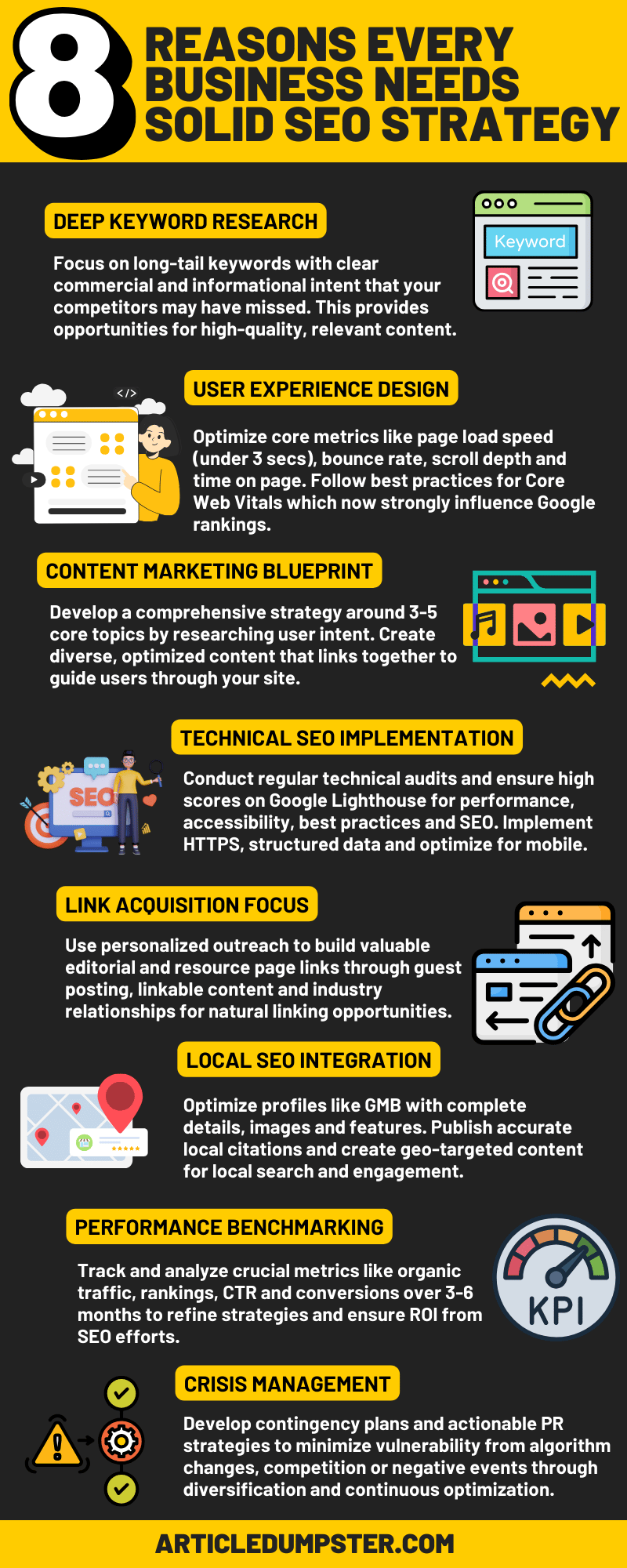Did you know over 50% of all web traffic comes from organic search results? A solid SEO strategy is the backbone for any business success that wants to thrive online. SEO is how you can effectively reach potential customers browsing websites through search engines like Google.
A solid SEO plan aims to rank high in search results for targeted keywords so your site appears to the right people at the right time.
A Solid SEO Strategy Goes Beyond the Basics to Dominate Serps – Here’s Why:

1. Deep keyword research
SEO pros go deep, using premium tools like SEMrush, Ahrefs, and Google Keyword Planner. They hunt for hidden gems – those untapped keywords your rivals missed. It’s not just about finding popular terms. Smart SEOs uncover long-tail phrases packed with user intent.
Consider this approach:
- Analyze the top 10 competitors’ content strategies
- Identify keyword gaps in your current strategy
- Unearth high-potential commercial and informational terms
- Focus on long-tail keywords with clear user intent
This thorough analysis shapes a robust keyword foundation. You’ll craft content that truly resonates with searchers’ needs. Remember, it’s quality over quantity. One perfectly matched long-tail keyword often outperforms dozens of broad terms.
2. User experience design
Google’s algorithms increasingly prioritize sites that users love. This means your SEO strategy must go beyond keywords and links. You must create an experience that keeps visitors engaged and returning for more.
Key areas to focus on include:
- Page load speed (aim for under 3 seconds for the least bounce probability)
- Mobile optimization (consider AMP implementation)
- Intuitive site architecture
- Clear calls-to-action
- Engaging, easy-to-read content
Don’t guess what users want. Conduct usability tests and analyze feedback. Track metrics like bounce rate, time on the page, and scroll depth. These insights guide your optimization efforts.
| UX Metric | SEO Impact |
| Page load time | Directly affects rankings and user engagement |
| Bounce rate | Signals content relevance to Google |
| Time on page | Indicates content quality and user satisfaction |
Remember, Core Web Vitals (CWV) now significantly influence rankings. Optimize for metrics like Largest Contentful Paint (LCP), First Input Delay (FID), and Cumulative Layout Shift (CLS). These technical improvements translate directly into better user experiences and higher search rankings.
3. Content marketing blueprint
Top SEO agencies don’t just create content haphazardly. They craft a comprehensive blueprint tailored to business goals and user needs. This approach ensures every content serves a purpose in the larger SEO strategy.
Key steps in developing a content marketing blueprint include:
- Identifying 3-5 core topics central to your business
- Researching user intent and pain points within these topics
- Planning diverse content formats (blogs, guides, videos, etc.)
- Creating a content calendar for consistent publishing
- Optimizing on-page elements for maximum impact
Smart content marketers don’t limit themselves to one format. They mix it up, catering to different learning styles and preferences. A single topic might spawn a blog post, infographic, and video series.
| Content-Type | SEO Benefit |
| Long-form guides | Targets multiple keywords, builds authority |
| Case studies | Attracts backlinks, showcases expertise |
| Infographics | Highly shareable, improves engagement |
Don’t forget internal linking. It’s a powerful yet often overlooked SEO tool. Strategically link between related pieces to boost relevance signals and guide users through your site. This keeps them engaged longer and improves your site’s overall SEO performance.
Distribution is key. The best content won’t help if no one sees it. Use email newsletters, social media, and outreach to amplify your content’s reach. This will increase visibility, attract backlinks, and drive valuable traffic to your site.
Remember, consistency is crucial. Stick to your content calendar and regularly analyze performance. Adjust your content creation strategy based on what resonates with your audience and search engines.
4. Technical SEO Implementation
While great content is essential, technical SEO ensures search engines like Google can easily crawl, understand, and index your site. Leading SEO providers focus on these critical technical aspects:
- Improving site crawl ability and indexation
- Enhancing page speed and Core Web Vitals
- Implementing structured data (JSON-LD) and social tags
- Optimizing images and other media files
- Ensuring mobile-friendliness across all pages
Tools like Google’s Lighthouse provide invaluable insights into your site’s technical health. Aim for high scores across Performance, Accessibility, Best Practices, and SEO categories. These improvements directly impact your search rankings and user experience.
| Technical Factor | Impact on SEO |
| Site speed | Affects rankings, user experience, conversions |
| Structured data | Enhances SERP visibility, click-through rates |
| Mobile Optimization | Critical for rankings in mobile-first index |
Don’t overlook local SEO elements. Verify and optimize your Google My Business and Bing Places listings. Ensure consistent NAP (Name, Address, Phone) information across the web. This boosts your website’s visibility in local search results and map listings.
Security is non-negotiable. Implement HTTPS across your entire site. Not only does this protect user data, but it’s also a ranking factor. Users and search engines alike prefer secure sites.
Regular technical audits are crucial. SEO isn’t a “set it and forget it” task. Conduct periodic crawls to catch issues early. Keep yourself updated about search engine algorithm updates such as the ones Google rolls out frequently, and adjust your technical strategy accordingly.
5. Link acquisition focus
Smart SEO strategies don’t just wait for links to appear. They actively seek valuable backlink opportunities. This process involves identifying relevant communities, blogs, and directories that align with your niche.
Effective link-building tactics include:
- Crafting personalized outreach pitches highlighting your unique value
- Creating high-quality, linkable content (often called “link magnets”)
- Pursuing guest posting opportunities on respected industry blogs
- Identifying and reaching out to relevant resource pages
- Leveraging relationships within your industry for natural link opportunities
Remember, quality trumps quantity. One link from a highly authoritative site often outweighs dozens from low-quality sources. Focus on building relationships, not just links.
| Link Type | SEO Value |
| Editorial links | The highest value signals content quality |
| Resource page links | Often relevant, good for topical authority |
| Guest post links | Valuable if on reputable sites |
When guest posting, aim for substantial, valuable content. Articles over 300 words allow for natural keyword inclusion and internal linking. This approach benefits both the host site and your SEO efforts.
Don’t forget internal linking. It’s a powerful yet often overlooked tactic. Strategically link to your most important pages (often called Least Competitive Pages or LCPs) to boost their visibility and ranking potential.
6. Local SEO integration
A comprehensive SEO strategy must include local optimization. This helps businesses appear in location-based searches and map listings. Key local SEO tactics include:
- Claiming and optimizing Google My Business (GMB) listings
- Ensuring consistency across Bing Places and Facebook business pages
- Publishing accurate citations on relevant directories
- Creating geo-targeted content for local audiences
- Acquiring links and reviews from local sources
When optimizing business profiles, include detailed information. Add high-quality photos, list all services, and specify service areas. If applicable, implement online ordering or booking features.
| Local SEO Element | Impact |
| GMB optimization | Crucial for local pack visibility |
| Local citations | Builds trust signals for search engines |
| Local content | Attracts nearby searchers, improves relevance |
Don’t underestimate the power of reviews. Encourage customers to leave testimonials and respond to all reviews quickly, both positive and negative. This engagement signals to users and search engines that you’re an active, customer-focused business.
Create online content that resonates with your local audience. This might include neighborhood guides, local event coverage, or region-specific tips related to your industry. Such content attracts local links and engages your community.
7. Performance benchmarking
Implementing SEO tactics and hoping for the best is not enough. Top SEO professionals constantly track and analyze performance, which allows for strategy refinement and ensures ROI.
Key metrics to monitor include:
- Keyword rankings for target terms
- Organic traffic volume and trends
- Click-through rates (CTR) from search results
- Time on page and bounce rates
- Conversion rates and goal completions
Set a benchmark at the start of your SEO campaign. Then, track progress over 3-6 months. This timeframe allows for meaningful data collection and trend analysis.
| Metric | What It Tells You |
| Keyword rankings | Visibility in search results |
| Organic traffic | Overall SEO effectiveness |
| Conversion rate | SEO impact on business goals |
Don’t rely solely on quantitative data. Conduct qualitative user research to understand the “why” behind the numbers. A/B testing can reveal which changes truly impact performance.
Regular reporting is crucial. Monthly reports help identify trends and areas for improvement.
8. Crisis management
A robust SEO strategy includes contingency plans for potential crises. These might include major algorithm updates, sudden ranking drops, or aggressive competitor moves. Key elements of SEO crisis management include:
- Developing action plans for common SEO emergencies
- Diversifying keyword targets to reduce vulnerability
- Continuously optimizing underperforming pages
- Maintaining a ready-to-deploy PR strategy
- Building a network of industry contacts for quick insights
Create keyword lists focusing on less volatile search areas. This provides a buffer against sudden algorithm shifts. Regularly optimize pages ranking below the top 5 positions. These present opportunities for quick wins during turbulent times.
| Crisis Type | Preparation Strategy |
| Algorithm update | Diversify traffic sources, follow best practices |
| Competitor surge | Monitor industry trends, maintain unique value |
| Negative PR | Have response templates ready, build brand advocates |
Don’t wait for a crisis to build relationships. Nurture connections with industry peers, journalists, and influencers. These contacts can provide valuable support and insights during challenging times.
Maintain a PR plan and resources for quick response. This might include pre-approved statement templates, a designated spokesperson, and a communication chain for rapid decision-making.
Remember, the best crisis management is often preventative. Stay informed about industry changes, adhere to best practices, and continuously improve your site. This proactive approach minimizes the risk of SEO emergencies.
Does Every Business Needs This Much Work for Their Website to Rank Well?
Not if your industry has very low online competition. You can use tools such as Semrush, Ahrefs, and Moz to find the most searched keywords in your industry and see the DA/PA of the websites ranked for these. If they’re over 30, there’s healthy competition in your niche.
To ensure you take over websites between 30 and 40 DA, you may have to work hard to get your website to 45 or 50 DA, and that too without manipulating the authority, like getting hundreds of backlinks from spammy domains. That won’t work in the long run.
But that doesn’t mean Domain Authority is the only factor to look for. Your competing websites will have gaps in content, link profile, website structure, and overall SEO. A good SEO service provider can recognize those gaps, create a strategy for your website accordingly, and skyrocket your rankings in just a few months.
Plus, to future-proof your business and ensure no new competitors with better strategies take over your spot in SERPs, you need to be proactive about strategy.
How to Ensure Your SEO Agency Has What It Takes to Make a Solid Strategy For Your Business?
Not all SEO agencies are created equal. Some excel at crafting comprehensive strategies, while others fall short. Request an initial audit to ensure you’re working with a top-tier agency. This audit should provide insights into your current SEO standing and identify key areas for improvement.
Next, ask for a detailed six-month plan. A quality agency will deliver a clear, tailored strategy addressing your business goals, industry challenges, and competitive landscape. Be wary of generic, one-size-fits-all approaches.
Key considerations when evaluating an SEO agency include:
- Experience with Local SEO
- Proven Track Record
- Holistic Digital Marketing Integration
Experience with Local SEO
Local search dominates many industries. A skilled agency should demonstrate expertise in local SEO tactics. They should know how to optimize Google My Business listings, manage citations, and attract location-specific backlinks.
Ask potential agencies about their local SEO experience. Request case studies showing improved local rankings and increased foot traffic for clients. An agency well-versed in local SEO can significantly boost your visibility in local search results.
Proven Track Record
Past performance often indicates future success. Look for agencies with a solid history of SEO wins. They should readily provide case studies and client testimonials. These resources offer valuable insights into an agency’s capabilities and results.
Don’t just focus on ranking improvements. Look for evidence of tangible business impacts. Has the agency’s work increased its clients’ leads, sales, or revenue? A truly effective SEO strategy should drive real business growth.
Consider asking the following questions:
- Can you share examples of clients in my industry?
- How have you helped businesses overcome specific SEO challenges?
- What’s your average client retention rate?
Long-term client relationships often signal consistent, quality work. Be cautious of agencies that can’t provide concrete examples of their impact.
Holistic Digital Marketing Integration
SEO doesn’t exist in a vacuum. It’s most effective when integrated with other digital marketing efforts. A top-tier agency should understand this interplay and offer a holistic approach.
Look for agencies that can coordinate SEO with:
- Content marketing
- Social media strategies
- Pay-per-click advertising
- Email marketing campaigns
This integrated approach ensures all your digital efforts work in harmony. It can lead to better resource allocation and more impactful results. Ask potential agencies how they align SEO with broader marketing goals.
| Integration Area | SEO Benefit |
| Content marketing | Creates SEO-friendly, engaging website content |
| Social media | Amplifies content reach and attracts natural backlinks |
Remember, a truly solid SEO strategy goes beyond technical optimizations. It should align with your overall business objectives and marketing efforts. The right agency will demonstrate how their SEO work supports your broader goals.
Don’t rush the selection process. Take time to evaluate multiple agencies. Ask tough questions and demand clear, specific answers. The effort invested in finding the right SEO partner will pay dividends in long-term online success.




